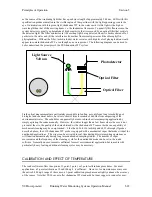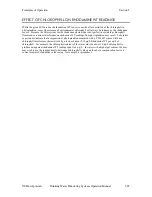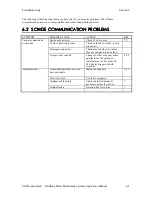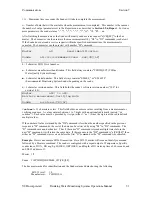
Principles of Operation
Section 5
YSI Incorporated Drinking Water Monitoring Systems Operation Manual
5-18
suspension should be determined by the extractive analysis procedure described in
Standard Methods
. Most
users will not have this analyzed plankton suspension available prior to field studies for use in the 2-point
calibration protocol resident in the sonde software. Thus, the best “calibration” method usually comprises the
following steps:
1.
Prior to use in the field, place the sensor in clean water and perform a 1-point calibration at 0 ug/L.
2.
Immerse the sonde in a dye standard (see below) and record the reading. Note that you are not
“calibrating” to the dye reading, only checking its value relative to the default sensitivity of the sensor.
3.
While making your field readings (sampling or unattended studies), collect a few grab samples and record
the date/time and location where they were acquired.
4.
On return to the laboratory, perform extractive analyses for chlorophyll on the grab samples and record
the results for later use.
5.
After the study is complete, place your YSI chlorophyll data in the column of a spreadsheet and place
your laboratory data in an adjacent column for comparison. Calculate ratios of field to laboratory results
for each grab sample point and then average the results to produce a ratio for adjustment (or
‘postcalibration”) of your field results into accurate chlorophyll readings (relative to extractive analysis).
6.
Use the calculating power of the spreadsheet to multiply all of your field readings by the correction ratio
to obtain the best possible accuracy for your 6025 data.
0A variation of this method is to perform a 2-point calibration prior to deployment using a clear water and a
dye standard, setting apparent chlorophyll equivalent of the dye standard to the value shown in the tables
below. However, it must be emphasized that this technique does not increase the accuracy of the chlorophyll
sensor significantly over the simple 1-point calibration recommended above – the user still must collect grab
sample and perform laboratory analysis to be assured of meaningful chlorophyll values. The primary utility
of the dye is to check for sensor drift during deployment by reanalyzing the dye solution after sonde recovery.
The use of the 2-point dye calibration procedure may make it easier to quantify the predeployment dye value
and, if so, may be preferable. Remember, however, that no real enhancement of sensor accuracy is attained
by using the dye as a calibrant.
PREPARATION OF RHODAMINE WT SOLUTIONS FOR CHECKING
SENSOR DRIFT
RHODAMINE WT STANDARD SOLUTION
CAUTION: Be certain to read and follow all the safety instructions and MSDS documentation which is
supplied with the dye before proceeding. Remember that only trained personnel should handle
chemicals.
Use the following procedure to prepare a Rhodamine WT solution for use as a sensor stability check reagent.
1.
Rhodamine WT dye is usually purchased in solution form and can vary somewhat in nominal
concentration. YSI uses Rhodamine WT from the supplier noted below and recommends that the user
purchase this exact item if possible. The solution is approximately 2 % in Rhodamine WT.
Fluorescent FWT Red Dye (Lot# 257201; 16 Fl. Oz.)
Kingscote Chemicals
9676 N. Looney Road
Piqua, OH 45356
1-800-394-0678
Fax: 937-773-7994
Содержание 600DW-B
Страница 3: ......
Страница 239: ...Principles of Operation Section 5 YSI Incorporated Drinking Water Monitoring Systems Operation Manual 5 26...
Страница 251: ...Warranty and Service Information Section 8 YSI Incorporated Drinking Water Monitoring Systems Operations Manual 8 4...
Страница 259: ...Required Notice Appendix B YSI Incorporated Drinking Water Monitoring Systems Operations Manual B 2...
Страница 264: ...EMC Performance Appendix D YSI Incorporated Drinking Water Monitoring Systems Operations Manual D 2...
Страница 268: ...Specifications Appendix E YSI Incorporated Drinking Water Monitoring Systems Operations Manual E 4...
Страница 297: ......
















































